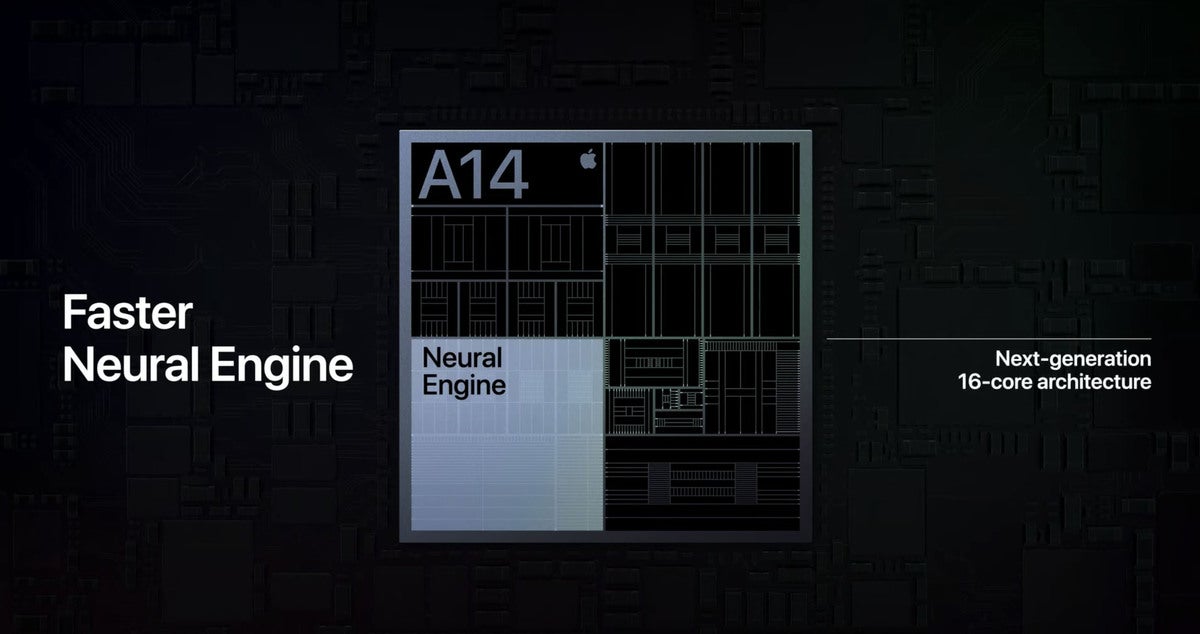 Credit: Apple
Credit: Apple
As it revealed the new iPad Air during its Time Flies event, Apple took the wraps off its latest mobile system-on-chip, the A14 Bionic. Built with a bleeding-edge 5-nanometer manufacturing process, it is Apple’s most advanced SoC ever and likely the fastest mobile chip on the planet.
Earlier this year, we took some educated guesses about what we might expect from the A14. Now that Apple has revealed a few details, this FAQ can tell you what this fantastic SoC is going to do for the Apple products in which it appears. As we get more information, we’ll update it.
The first 5nm chip
As expected, Apple claims to be the “first in the industry” to make use of the 5nm process technology to manufacture chips. That means smaller chip features and more transistors in a given amount of area. It also typically means lower power consumption for a given amount of work.
The process allows Apple to stuff 11.8 billion transistors into the A14. That’s about 40 percent more than the 8.5 billion in the A13.
All of this means more cores, more cache, and more advanced features.
Still a six-core CPU, but faster
Just as in the A11, A12, and A13, you’ll find six CPU cores in the A14; two high-performance cores and four high-efficiency cores. Apple says the CPU has been given a “big update” in the A14, and that it runs more instructions in parallel.
Without further explanation of what that means, it seems safe to expect that that A14 has a wider superscalar design that can issue and process more instructions per core at once. That means more instructions per clock (IPC), which tends to offer better performance at lower clock speeds.
Apple says the A14 has “large high-performance caches” that are “sized to meet the needs of the most demanding applications.” That probably means an increase in L2 cache over the 8MB in the A13, or perhaps even the introduction of L3 cache, which hasn’t been seen in an Apple SoC yet.
Apple said the CPU is 40 percent faster than the one in the previous iPad Air, but that tablet had an A12 in it. Apple said the A13 was 20 percent faster than the A12; that would make the A14’s CPU about 17 percent faster than the A13.
An all-new GPU
The A14 also features Apple’s newest GPU architecture with four GPU cores, the same number as in the A13. Apple says it is “scaled to deliver the maximum sustained performance at the lowest possible power.”
Apple says it delivers a 30 percent increase in graphics performance, with the disclaimer that it is compared to the “previous generation device.” Again, the previous iPad Air had an A12. Apple said the A13’s graphics are 20 percent faster than the A12, so this isn’t a big leap.
Double the Neural Engine
Since the A11 (the first Apple chip to carry the “Bionic” monicker), Apple has included a custom silicon block called the Neural Engine in its SoCs. This hardware is tailor-made to perform the kind of operations used in machine learning and AI calculations. In that chip, the Neural Engine performed 600 billion operations per second.
 Apple
Apple
Apple doubled the number of Neural Engine cores, because ML and AI tasks are the future.
That grew to 5 trillion in the A12 and 6 trillion in the A13, with the latter also adding in special matrix hardware in the CPU cores.
The A14 doubles the Neural Engine from 8 cores to 16, delivering an impressive 11 trillion operations per second. The matrix acceleration hardware in the CPU cores in now a faster “second-generation” design as well, through Apple has given no indication of what the differences are.
Much we still don’t know about A14
For all that Apple has revealed about the A14 Bionic SoC, there is still much left to learn. Modern mobile system-on-chip designs have lots of custom acceleration hardware: image signal processing for the cameras, video encoding and decoding, cryptography and encryption acceleration, storage and memory controllers, and more.
 Apple
Apple
There’s a lot in the A14 and we’ve only just scratched the surface.
All of these things can have a meaningful impact on the experience of using our iPhones, iPads, and soon, our Macs. We’ll probably hear more details about the A14 when Apple unveils the iPhone 12 line, likely in October.
One thing that struck me was the emphasis on expanded cache for intensive workloads in the CPU and “sustained performance” for the GPU. These are architectural concerns most suited to laptop and desktop processors, and a good indication Apple is building an architecture to perform better in macOS (perhaps scaled up to an “A14X” style design).

















